
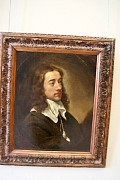
Charles Le Brun (1619-1690)
Louis Testelin (1648)
The artist and the subject of this portrait were fellow artists and friends.
I find the gaze of the subject curious, off to the side and up.
Le Brun is the artist who produced so much art for the Palace of Versailles.
|
|
|
|
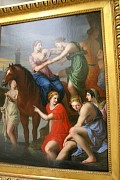
Jacques Stella (1596-1657)
Clélie passing the Tiber (1648)
I can't find much on the subject of this painting - apparently these Roman virgins are
about to swim the Tiber to get away from the Etruscans. Apparently, it's okay for
the early Romans to kidnap the Sabine women, but those nasty Etruscans can't play
the same trick on the Romans. That said, I liked the use of color in this painting,
and that Roman maidens dressed more skimpily than modern lingerie models (if we
can believe Stella).
|
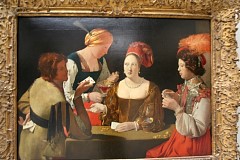
Georges de la Tour (1593-1652)
The Card-sharp and the Ace of Diamonds (1625)
Yet another iffy photo on my part, but again included because the quality of the painting.
The well-dressed youth on the right is obviously a mark for the other three figures
in the painting to cheat. What strikes the viewer is first the realism of the figures and
then the way the light portions of the
figures crisply jolt to the jet black of the background.
|
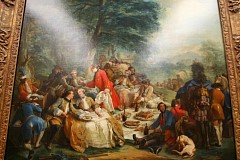
Carle Vanloo (1705 - 1765)
The Hunt Lunch - 1737
I subtitle this, "The Dandies Hold a Picnic". Even so, there are lots of female
figures in the painting. I wonder how historically realistic this scene is.
|
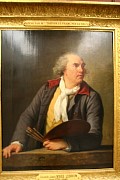
Elizabeth-Louise LeBrun (nee Vigée) (1755-1842)
Hubert Robert (1788)
This portrait is of a man who before the French Revolution had been the
"Designer of the King's Gardens" and the "Keeper of the King's Pictures".
During part of the struggle Robert was imprisoned and narrowly escaped the
guillotine when through error another prisoner died in his place.
He was freed at the fall of Robespierre.
I find the same inherently optimistic view of a person LeBrun seemed to capture
in her earlier (on the last web page) portrait of her daughter and herself.
|
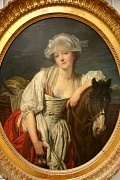
Jean-Baptiste Greuze (1725-1805)
The Milkmaid (undated)
Greuze is known for his portraits. This is not just any milkmaid, the subject
is his wife. I am not sure why he used her as a model: either paint your
nice looking wife, or find a real milkmaid. Just some advice to a long-dead
painter. Greuze's other portrait subjects include the dauphin, Robespierre,
and Napoleon. During the Revolution Greuze lost
both fortune and popularity, and died in poverty.
|
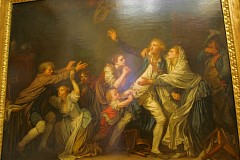
Jean-Baptiste Greuze (1725-1805)
The Curse paternal - 1777
This is Greuze's other painting style - moralistic. Toward the end of the
eighteenth century it had lost it's popularity. The figure at the far right is
an army recruiting officer, who looks on in amusement as the new recruit leaves
the bosom of his family. The recruit's father is very upset. I took notice of
this painting because of the over-the-top drama it portrays - only the older
mythology style is similar.
|
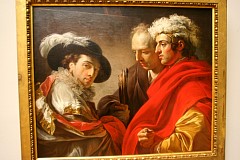
Francois-Andre Vincent (1746-1816)
Portrait of Three Men - 1775
Figures de fantaisie are portraits in which the sitters wear theatrical
or historical costumes as opposed to the kind of clothes they might ordinarily wear.
Vincent himself is the figure on the left in Spanish
costume. On the right is the French architect Pierre Rousseau. In back is probably the
painter Philippe-Henri Coclers. I just couldn't imagine what this painting was about,
and had to get home and translate the French (I took a picture of the nameplate).
|
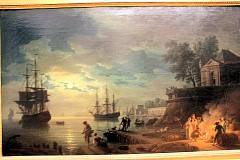
Claude-Joseph Vernet (1714-1789)
La Nuit, au Port au Clair de lune - 1771
(The Night, in the Harbor in Moonlight)
For twenty years Vernet lived on in Rome, producing views of seaports, storms, calms,
and moonlights. In 1753 he was recalled to Paris: here, by royal command, he painted the
series of 15 seaports of France. I just liked the attempt to capture the moonlight scene.
|
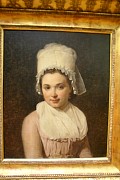
Jacques-Louis David (1748-1825)
Catherine-Marie-Jeanne Tallard - 1795
Our old friend Ingres was a student of David.
This is just a simple portrait of a very slight woman made just at the end of
the French Revolution. David is known for paintings of classical scenes. David
also did many paintings of both figures of the Revolution (Marat)
and flattering depictions of Emperor Napoleon I.
In 1816 after the fall of Napoleon came the Bourbon restoration. David
was banished as a regicide, and fled to Brussels, where he spent his last 10 years.
|
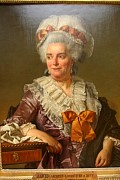
Jacques-Louis David (1748-1825)
Madame Charles-Pierre Pecoul - 1784
This is the mother-in-law of the artist. It's eleven years earlier than the
portrait of Madame Tallard (just above) but both women wear a bonnet. I would
think French fashion would not stay static.
|
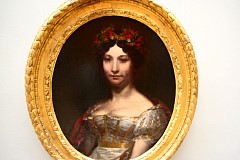
Pierre-Paul Prud'hon (1758-1823)
Portrait of Madame Jarre - 1784
Madame Jarre is dressed in a white empire gown.
Prud'hon gained the favor of Napoleon himself, serving as portraitist to both Empress Josephine and Napoleon 2nd wife, Marie-Louise, as well as instructing them in drawing. And perhaps most
importantly, he painted huge, amorous allegories with titles like Love Seduces
Innocence, Pleasure Entraps and Remorse Follows.
Yet today his reputation is limited. Part of Prud'hon's problem, then as now, was the strength of the competition -- especially the influential Neoclassicist Jacques-Louis David and his followers.
|
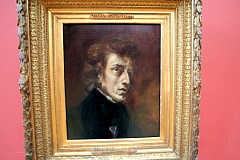
Eugene Delacroix (1798-1863)
Portrait of Frederick Chopin (unfinished) - 1838
This is the painter who produced Liberty Leading the People. There
is a kind of Impressionism in this portrait, although that style has yet to be
recognized at the time of this painting. This painting is considered unfinished,
but I can't tell you why.
|
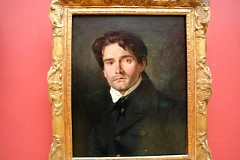
Eugene Delacroix (1798-1863)
Portrait Leon Riesener - 1835
Delacroix made relatively few portraits, mostly of friends and family.
Leon Riesener is the artist's cousin. I notice that this portrait is
the very image of my son-in-law Joel.
|
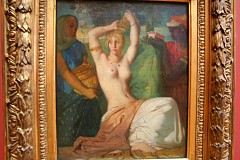
Theodore Chasseriau (1819-1856)
Esther at her Toilet (1841)
Chasseriau was a student of
Ingres .
I think the student has done a better job with female anatomy. It's more
difficult to count vertebrae from the front, but the right number seem to be there.
Esther has her own
book of the Bible. This painting makes me want to read more about her ...
|
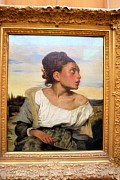
Eugene Delacroix (1798-1863)
A young orphan at the Cemetery - 1824
Grief ...
|
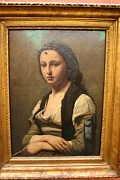
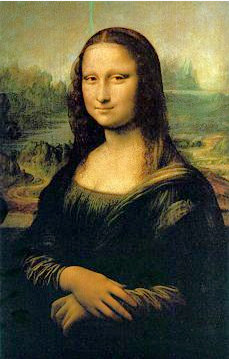
Jean-Baptiste Camille Corot (1796-1875)
Woman with Pearl (1868-70)
Corot travelled extensively, but often was inspired by famous paintings in the Louvre.
The inspiration for this painting is Mona Lisa.
|
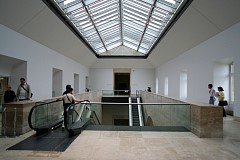
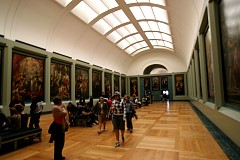
Just some scenes to document the feeling of being in the Louvre. As the galleries get
crowded, sometimes while standing near a painting you are interfering with the view
of those viewing while seated. Everyone remains polite.
|
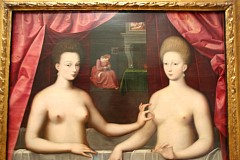
Anonymous
Gabrielle d'Estrees and One of Her Sisters (1594)
Gabrielle was the mistress of Henri IV (Henri de Navarre, Henri de Bourbon), 1553-1610,
first Bourbon king of France who's famously converted to Catholicism to become king of
France with the quote,
"Paris is well worth a Mass."
The oddly affectionate way in which the sister is pinching Gabrielle d'Estrées' right breast
has often been taken as symbolizing the latter's pregnancy with the illegitimate child of
Henry IV. I have a hard time thinking exactly where this painting could have been hung.
Perhaps only in Henry's private chamber, where his wife could never visit?
When she died in 1600, Henry wore black mourning dress, something no previous French
monarch had done before.
|
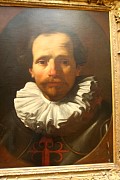
Simon Vouet (1590-1649)
Portrait of Giovanni Carlo Doria 1621
Vouet's style was distinctly Italian. He studied his craft in Italy in these years 1613 to 1627,
mostly in Rome, just as the Baroque style was originating.
His portraits of the court of Louis XIII and most of his large-scale decorative schemes for Parisian houses and country chateaux have been destroyed. This painting was done by the artist
for his patron, a member of the wealthy Italian Doria family. In my opinion, there is something very
vulnerable in the facial expression.
|
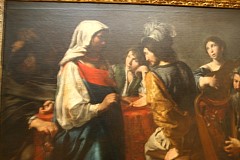
Valentin de Boulogne called Valentin (1594-1632)
The Fortune Teller - 1628
Valentin studied under Simon Vouet. Yet another bad photo by me - I did much better
in the Munich art galleries. I think the "lesson" in this painting is that the
fortune teller, who undoubtedly is taking advantage of the man whose palm she reads,
is herself a victim of crime - her pocket is being picked.
|
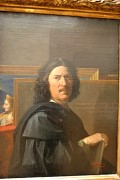
Nicolas Poussin (1594-1665)
Self Portrait - 1650
I just like the countenance the artist has chosen for himself - it's like he is taking a critical
self appraisement like anyone might do while looking at themselves in a mirror.
|
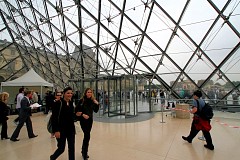
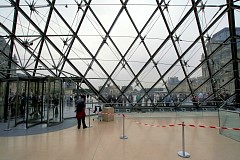
|
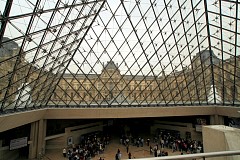
Let's say goodbye to the Louvre. I only had part of a day to spend here, and certainly
didn't even come close to covering it all. I missed the Dutch painters for sure, and
the apartments of Eugenie and Napoleon III, who lived in part of the museum before it
was a museum. When I was here before your weren't allowed to stop and take pictures
on the way out. I like the split level picture (left).
When I left I walked all the way to the Arc de Triomphe, then took the Metro back
to the Saint-Michel stop.
|
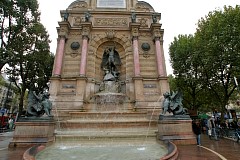
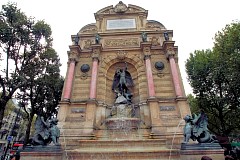
Back on the Left Bank, here is Saint Michel square.
The fountain in the center of the square was created in 1860 by French sculptor Davioud and represents Saint Michel, protector of France, slaying a dragon.
|
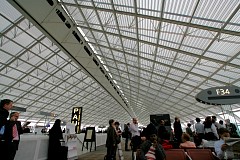
Here is a shot I took in Charles De Gaul airport during the long flight delay.
Here is my complaint about Northwest and KLM airlines. It was foggy that morning so
the initial KLM flight was late. FOR SOME REASON Northwest and KLM can't streamline
the passport process - you have to have it inspected in Paris, land in Amsterdam,
wait in line again to have it inspected AGAIN, then grab your next flight. I get
why this happens, what I was mad about was the lack of cooperation between airlines
that I thought were partners. When I finally
got to Amsterdam, I had only a half an hour to get on my next flight. The line
for U.S. passport inspection was huge, the line for European Union citizens was
very short. Finally, somewhat exasperated, I joined the EU line and passed through.
The agent didn't yell at me for using the wrong line, he just told me nicely he
didn't think I could make my connecting flight. I got to the gate just as they
were closing it, but they wouldn't let me on the plane.
I had to go back into the airport to find an airline agent. Evidently they put the
best agents in the "conflict resolution" desk to deal with crabby customers like
me. The guy ahead of me was flying to the West coast, and no more flights were
available. He had a visa for Holland, so they put him up in a hotel. He told
the man that had he not had a visa, he would have had to sleep in the airport.
Of course, I have no visa. Fortunately, the agent found me a seat so in few
hours I flew back to the States. The reason I couldn't board the 2nd leg of my original
flight was, this "uber-agent" explained, because since my luggage had not
made it on the plane, I couldn't fly. If there was a bomb in it, at least they
want me to blow up too. The rule is if your luggage is not on the plane, you don't
fly. Likewise, if your luggage is on the plane, and you don't make it, they take
your luggage off.
The gate agents could have told me this, but didn't. KLM and Northwest didn't
seem to think about the connecting flights of those on the delayed first fight.
I have been held up on plenty of planes waiting for people making connections.
When I got off the first plane, a cart was there to take some people to their
next flight. I was told I would have had to arrange this in advance. So what,
in advance I plan for my initial flight to be late and arrange for a cart?
Next time, I am going to do this - everyone should do this - arrange for carts
in anticipation that your flight will be late. If the whole planeload
of passengers requests transportation to the next leg of their flight,
soon Northwest/KLM
will figure out how to coordinate connecting late flights.
|